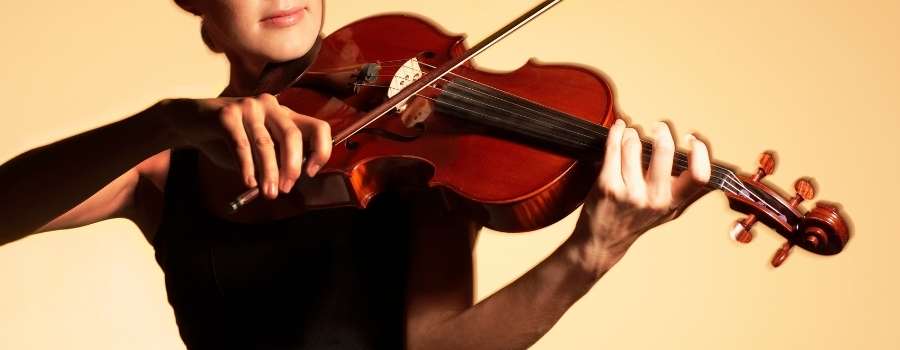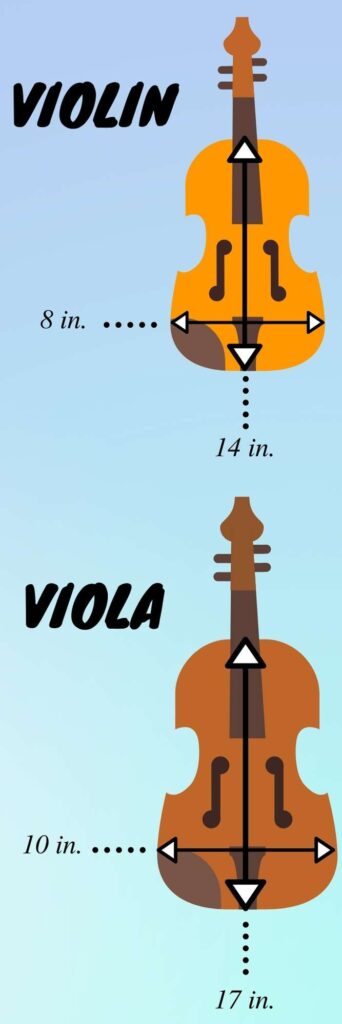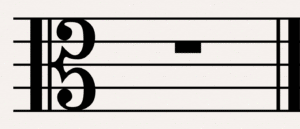
The Viola…sometimes considered the middle child of the string section…you don’t get the respect you deserve. Often, it’s the students who are struggling with the violin that get relegated to the viola section, and in the case of some pit orchestras and small ensembles, you’re cut altogether.
Unfortunately, these circumstances have given the viola a reputation for being a simplistic instrument…just bodies to fill in the middle of a chord.
The viola is more difficult to play than the violin. Due to its size, the viola is heavier to hold, requires more finger strength for the strings and more wrist strength for vibrato. In addition, viola players are required to learn how to read the alto clef and must seamlessly blend with the cello section and violin section.
That, in a nutshell, explains the main reason playing the viola is harder than playing the violin…but, down below, I’m going to unpack them and see if I can.
I mentioned the main struggles viola players have up above, but here is a list of 6 culprits to be aware of. I think a big takeaway from this list is to look at this list as “challenges to take on” rather than “reasons to not play the viola.”
What Makes The Viola Harder To Play Than The Violin?
- Instrument Size
- Instrument Weight
- Alto Clef
- The ‘C’ String
- Often Used as a Support Instrument
- Ridicule and Snobbery (At Least a Little)

Instrument Size
A full-sized, adult violin measures about 14 inches long (measured at the back of the body) and a little over 8 inches at the widest point. A viola comes in at about 17 inches long (again, measured at the back of the body) and just shy of 10 inches at the widest point.
It’s important to note that, unlike violins, violas don’t have a strict standard of measurement…so brands and models can vary several inches from each other.
Another important thing to remember is that these measurements are for full-sized “adult” instruments. Since children can start learning the violin (and subsequently the rest of the string family) at very early ages many instruments will come in smaller sizes…3/4 size, for instance.
Instrument Weight
Violins will weigh approximately 1 pound (16 ounces) and violas come in just a bit heavier at 1.3 pounds (21 ounces.)
Now, this doesn’t seem like a whole lot of weight to begin with and a minuscule difference between the two. But remember, this is a weight that has to be held up for several minutes at a time over the course of many hours of practice time a day…so those extra 5 ounces will start to feel like barbell weights pretty quickly.
Also, keep in mind that other factors will change the general weight of an instrument. Strings can vary a bit in weight depending on the material, shoulder rests and chin rests can also be a big factor. Even playing techniques will compound the weight of the instrument.
If you’re playing light, legato passages then the bow will just be gliding across the strings. But if you’re playing col legno or heavy staccato notes then you are beating down on the strings, temporarily adding to the weight not to mention extra stress and strain to your shoulder, neck, and left arm.
Alto Clef
Violas…you just gotta be different. While the vast majority of musicians will play the treble clef or bass clef, violas use one called the alto clef. They will also make use of treble clef from time to time if their music is going to sit in a range more fitting to that clef for several measures, but the majority of the time they will be reading alto clef.
What is Alto Clef?
Alto clef, also known as ‘C’ clef or moveable ‘C’ clef, is a clef used almost exclusively by viola players. While the treble clef indicates where ‘G’ above middle ‘C’ is and bass clef shows where ‘F’ below middle ‘C’ is, alto clef marks the location of middle ‘C’ itself.

The viola has a playing range that goes far below the treble clef and far above the bass clef. Writing in either of these two clefs would require the use of leger lines, making music more difficult to read. It would also make the life of music copyists much more difficult and time-consuming…remember, the viola was around long before home printers and mass production copiers.

As you can see from the image above, the same one-measure tune sits much better on the alto clef than it does on treble or bass clef. With those clefs, you end up with several leger lines which makes it cumbersome to play and can make the music look very cluttered.
The ‘C’ String
Most, if not all, musicians who choose an instrument from the string family will start on violin…sometimes at very young ages! By the time these players get to junior or senior high school, where switching to viola becomes an option, they may have already been playing violin for 6 – 8 years. This means they are very familiar with the strings of a violin, G-D-A-E (from low to high.)
A Viola shares the G, D, and A strings with a violin but eliminates the high E string and adds a low C string. A viola string layout is C-G-D-A (again, from low to high.)
This means any muscle memory a player had from years of violin practice will need to be relearned since the positions of notes have shifted. A viola is also a bit bigger, so the spacing between notes is also different and requires more left-hand pressure and bow pressure to play.
AND there is a whole new string to learn positions for.
Often Used As A Support Instrument
While violins and cellos are passing melody lines between each other and basses are chugging away on those awesome, rumbly low notes, violas are usually getting the middle notes of chords and playing a lot of whole notes (or eggs, as we used to call them in jazz band) or playing arpeggiated lines. At least lines written as arpeggios have a little movement and interest to them.
Getting stuck playing the interior notes of chords often leads to odd jumps in the line. Melodies are usually pretty linear allowing the players to “hear” or anticipate what is coming next…this is one aspect of site reading.
But if you’re always playing the interior notes you may end up with weird jumps in your music which is much harder for your eyes to read ahead on while you’re playing. Your ear can’t quite anticipate as easily either, especially when confronts with progressions that don’t sound “cadence” like…looking at you tritones!
If you are a viola player that plans to stick with it through college and into adulthood, work extra hard at your ear training.
I’ve played in some pit orchestras and have scene some film scoring recordings where the violas are just omitted altogether. I’m afraid I’m even guilty of this in some of my film scoring work. This makes it a fault of composers, not musicians and plays into the next topic.
Ridicule And Snobbery
The stereotype about viola not being as difficult to play as violin likely got its start back in high school. If violin players were struggling they would often be shifted to viola. So if you end up with a section full of struggling players, it ends up enforcing the stereotype.
When you think about it, putting struggling players on the viola doesn’t make sense. Now they are forced to hold a heavier instrument with a slightly different string setup and learn a new clef…so the struggles continue. There have also been times when orchestra directors will coax kids into switching to viola in order to flesh out the section…this is good for the ensemble, but not always great for the individual player.
Viola is also an instrument a lot of kids don’t choose to play at first blush…opting for violin and cello instead. Violin and cello are often “the star” of any concerts and often get the big melodies and solos. This plays in a bit to the point up above about the viola being used as a support instrument. This isn’t the fault of the player, but really about how the composer uses them.
Where Violas Shine
Some composers, old and newer, did recognize the beautiful and rich tone that violas provide. Andrew Lloyd Webber and Phillip Glass chose to not use violins in “Requiem” and “Akhnaten,” respectively. And classical composer Haydn had the violins sit out and used violas and cellos for “The Creation,” oratorio while Bach had the violins sit tacet (meaning they’re in the orchestra, but don’t play for a movement)for the sixth movement of “The Brandenburg Concerto.”
String quartets give individual players more spotlight. While violins and cellos will still dominate the melody most of the time, the individual parts are typically more interesting and nuanced than full-string orchestra parts. There is more interplay between the musical lines of each instrument…rather than just “filling in the chord.”
And of course, there are the solo works. Every instrument has had solo pieces composed specifically for them, and the viola has some wonderful sonatas, concertos, and solos written for it. This is just a small list of some greats:
- Sinfonia Concertante – Mozart
- Don Quixote – Strauss
- Two Songs for Alto, Viola and Piano – Brahms
- String Quintet No. 3, Op. 97 – Dvorak
- Viola Concerto – Walton
Final Thoughts
As a composer, I love the viola and that rich middle tone that it has…so wear these challenges like a badge of honor. You’re playing a very lush, sonorous instrument that extends the full sound of the violin’s lower notes and maintains a full sound in what becomes very thin and nasal for the cello section’s upper register.
As a violist, you’ll also have more potential to move up in position within the section. A typical violin section has 16 firsts and 14 seconds, so 30 some odd people competing for position whereas a viola section will have around 8 seats. You’ll still have to work hard to excel at the viola, but you should be able to move up in position a lot faster than a violinist.
